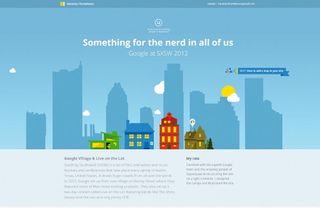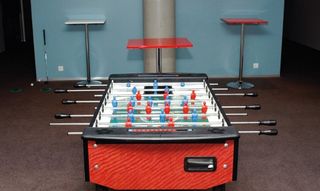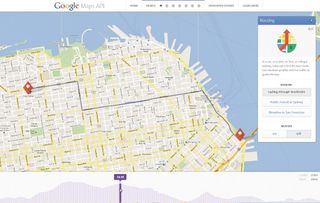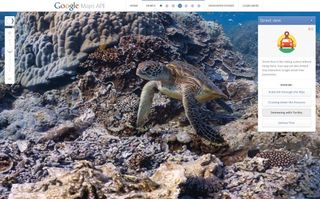Haraldur Thorleifsson on being a nomadic designer
Martin Cooper chats to the prolific web designer not confined by geographical location.
Despite dabbling in everything from philosophy to finance and structural engineering in his younger years, design has been the one constant in Haraldur Thorleifsson – aka Halli's – life. And once he'd settled on a career pushing pixels, there was nothing half-hearted about his efforts.
So far he's racked up a client list that includes Google, The Economist, YouTube and Microsoft, set up his own full-service agency – Ueno – and picked up Webbys, Awwwards and FWAs – not to mention a net award for his outstanding portfolio site. We chatted to the nomadic designer to find out how he got started, the key to a great personal site and what it was like working with Santa.
Hello! Why don't you introduce yourself and your work?
Hey there! My name is Halli, I'm a creative director and designer of things that appear on screens. I'm the founder and principal of Ueno, a full-service digital agency. I'm originally from Iceland but for the last few years I've been working mainly for international clients. Our current clients at Ueno include great companies like Google, Fitbit, Reuters, Medium and Dropbox.

When did you first become interested in design?
I started designing after I took an IT course as part of my studies in finance at the local university. I quickly moved on to Flash, where I stayed for a few years, and then I came back to design. I've really only ever designed pixels. I can't draw much on a piece of paper, and print design has never interested me – there's way too much physical stuff in the world.
What's your career path been?
For a long time I had an on-again, off-again relationship with design. I used design to support myself through university, finishing a BA in philosophy, a BS in finance and then I went on to an MS degree in economics. Around the time I was looking for topics for my dissertation in economics I realised I didn't want to be an economist, so I put that on hold and started to design again. At one point or another I have studied construction engineering, development studies for the Third World and song-writing. I guess you could say I've been all over the place, but for the last five to seven years most of my professional work has been in some way related to design.

In 2007 I moved to New York to work for Cuban Council, which was a small digital agency with some very big clients. I stayed there for about a year before moving back to San Francisco to focus on my freelance career. I did a lot of work with Upperquad, a SF-based agency, and then late last year I started my own digital agency, Ueno, based in Iceland.
What prompted you to start your own agency? Did it throw up any unexpected challenges?
I had been working on my own for about seven years and the projects were getting bigger and more complicated. I always had collaborators that I would bring in on projects, as needed, so in a way I was already running an agency. But I realised I was hitting a ceiling on scale, and I also had problems explaining to potential clients that they weren't just getting me, it was a full digital offering. So I gathered some of my collaborators, found a few new people and brought it all into a single entity. I think the challenges are there but none that I wasn't expecting. To be honest I was expecting it to be harder than it has proven to be. But it's early days yet, check back with me in a few months!
You've worked with a huge number of top tech companies. How do you go about landing such big clients?
The first steps are always the hardest, but once you have a good track record and some solid projects under your belt, you can use those as proof of your ability. We get a lot of work referred to us, so it helps to have good relationships with clients – my tips would be to deliver on time, be nice and help them achieve their goals. I also get a lot of project requests through my personal website and Dribbble account. My site has been featured here and there and I've managed to build up a large Dribbble following, which helps.

Again, with such a roster of clients, how do you keep yourself creatively fresh? Do you ever feel burned out?
I sometimes work too much and it almost always leads to burnout. I think the 40-hour work week is there for a reason. You need to spend time with your family and friends. Travel, listen to music, meet new people. Basically take time to enjoy life before it's over.
What advice would you give a senior designer looking to step up and become a creative director?
Know your strengths and weaknesses. Build your own team and know their strengths and weaknesses, too. Trust the people you work with, give them as much creative freedom as possible but know when to nudge them onto the right track. Have a vision for the project and be prepared to fight for it. Realise that the client has business objectives that might not necessarily fit your original creative vision. Adapt. Realise you are very likely living in a designer-developer bubble, so you might want to expand your circle of friends.
You won Best Online Portfolio in this year's net awards. Congratulations! What's the secret to a good portfolio site?
Thanks! Well, having good projects to show off is obviously a plus. I try to build a story around the projects, draw out interesting assets and concepts, give a bit of a glimpse of what happened behind the scenes and show a bit of my character. I also had quite a bit of help from my good friend James Dickie, who did all the coding and had some great ideas and insights.

The Google Santa Tracker site was a big hit. How did the project come about?
The Google Maps team came to Upperquad in the autumn of 2012 and asked if the team had some good holiday ideas. The core idea of the Santa Tracker – a site where kids could follow Santa as he travelled the world, handing out gifts – was already there. But we quickly realised that we needed some kind of platform to build suspense before the 24th, so we came up with the idea of Santa's Village. In 2012, Santa's Village had a few games and scenes but in 2013 we went all out, created 24 unique experiences and turned the whole village into an advent calendar.
And – without using the word 'magic' – how does the site work?
For me 'magic' is pretty much the right word. I don't code, myself, so I can't really go into the specifics of it but we had such an amazing group of developers and they pretty much were able to pull off all the insane ideas we threw at them. By the end they even managed to make the whole site (games and all) fully responsive which I think is a truly remarkable feat.
The Santa project team was distributed all around the globe. What challenges did this present?
Most of the work I've done in the last seven years or so has been done off-site so at this point I am pretty used to it. For me it means spending a lot of time on Google Hangouts and I have come quite good at calculating what time it is in different parts of the world. When we did the first Santa project I was in Tokyo and I decided that I wasn't going to let geography get in the way when sourcing the talent. So I started building the best team I could find. By the end we had a lead illustrator in New Zealand and key people in Sydney, Chicago, Reykjavik, London, Stockholm and a bunch of other places. There were some early mornings and late nights, but in the end it all worked out.

What's the biggest lesson you've learned about working with a team spread across the world?
I spend about half my day on Google Hangouts. It's probably the one piece of software I couldn't really work without. It's simple and easy to set up for new people, but the killer feature for me is the focused screen sharing. I've also tried to use project management tools like Basecamp but I always go back to good old email. The simplicity and flexibility of it is hard to beat!
Looking across the web, whose work is impressing you most at the moment?
On the agency side I think Hello Monday is at the top of its game. B-Reel, Fi, Odopod (now Nurun) usually produce great work as well. I always enjoy the work of people like Claudio Guglieri, Anthony Goodwin and Brijan Powell, and I've actually been fortunate enough to work with all of them on different projects.
What's the secret to growing the best beard?
Don't shave.
Words: Martin Cooper
This article originally appeared in net magazine issue 257.

Thank you for reading 5 articles this month* Join now for unlimited access
Enjoy your first month for just £1 / $1 / €1
*Read 5 free articles per month without a subscription

Join now for unlimited access
Try first month for just £1 / $1 / €1
Get the Creative Bloq Newsletter
Daily design news, reviews, how-tos and more, as picked by the editors.
The Creative Bloq team is made up of a group of design fans, and has changed and evolved since Creative Bloq began back in 2012. The current website team consists of eight full-time members of staff: Editor Georgia Coggan, Deputy Editor Rosie Hilder, Ecommerce Editor Beren Neale, Senior News Editor Daniel Piper, Editor, Digital Art and 3D Ian Dean, Tech Reviews Editor Erlingur Einarsson and Ecommerce Writer Beth Nicholls and Staff Writer Natalie Fear, as well as a roster of freelancers from around the world. The 3D World and ImagineFX magazine teams also pitch in, ensuring that content from 3D World and ImagineFX is represented on Creative Bloq.
